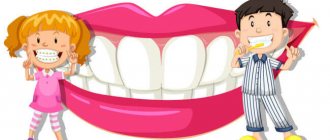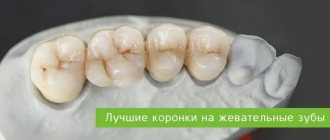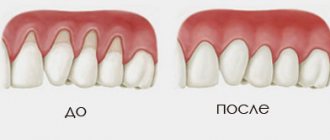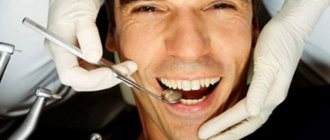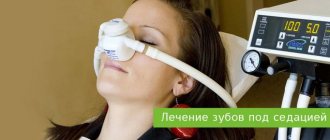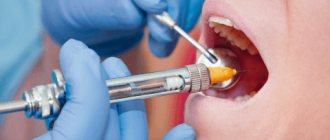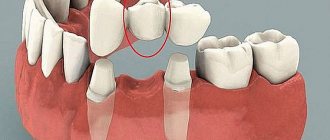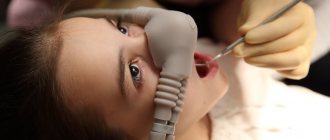Is it painful to treat caries?
One of the most frequently asked questions when going to the dentist is whether it hurts to treat caries. Sitting down in a chair, we warn the doctor that we have a low pain threshold and, in general, we are simply afraid. The doctor will definitely select a drug that will make the treatment comfortable and painless, even in the most difficult cases.
Today, caries can be cured absolutely painlessly.
Content:
- Where can you cure caries painlessly?
- Types of anesthesia in dentistry
- When not to use local anesthesia
- Anesthesia and sedation in dentistry
- Anesthetics used in dentistry 5.1. Medicines based on aticaine 5.2. Painkillers containing mepivacaine
Is it painful to treat teeth?
This question worries almost any person planning to undergo dental treatment. In fact, the problem of pain relief in dentistry has always been very acute. Almost all medical procedures performed by a specialist cause severe discomfort. Knowing this, people are afraid to treat caries, pulpitis and other oral diseases. But refusal to seek medical help in a timely manner invariably entails another problem - the progression of the existing pathology. After all, dental diseases do not go away on their own. Over time, they become more pronounced and are less responsive to therapy.
Therefore, it is important to prevent the patient from having a negative experience associated with the lack of adequate pain relief. For this purpose, more and more effective anesthetics are being developed every year. Using them in their work, dentists can offer their clients the most comfortable and completely painless dental treatment.
Without anesthesia
In rare cases, doctors have to carry out treatment without anesthesia. This usually happens when there is an allergy to anesthetics. If the patient is intolerant to drugs, the doctor may suggest treatment with laser or chemical reagents. General anesthesia is also an option.
As a rule, the majority of people prefer to undergo treatment under local anesthesia. But there are brave souls who have a high pain threshold or even prefer to do without an injection.
If we are talking about superficial caries, when the tooth tissue is not yet damaged, then this is understandable. But with medium and deep caries, such pain is almost impossible to endure without anesthesia. And it’s not necessary - the latest generation of anesthetics do not cause allergic reactions, they can be used even when treating children and pregnant women.
There is no point in being a hero when treating teeth - without anesthesia it will hurt. And talking about savings also makes no sense.
Anesthesia and sedation in dentistry
If a patient asks for general anesthesia due to panic, then he can be offered sedation. This is an alternative to "deep sleep". Thanks to it, during therapy the person is half asleep and does not feel pain.
Anesthesia is used very rarely in dentistry, only if a serious and complex maxillofacial operation is to be performed. Its use is also relevant if the patient has a low pain sensitivity threshold and is allergic to all local painkillers.
On the front teeth
The main feature of caries on the front teeth is that it develops very quickly. Due to the high load, the enamel quickly becomes thinner, causing tissue destruction to occur at a rapid pace. In advanced cases, severe pain begins, especially while eating. It is also necessary to talk about the aesthetic aspect - caries on the front teeth instantly attracts attention.
It is not painful to treat caries on the front teeth under local anesthesia. Perhaps the doctor will slightly increase the dosage of the drug to completely eliminate sensitivity.
Important. If you notice a spot or initial caries on your front teeth, we recommend that you immediately contact your dentist. If you wait, you risk losing a tooth in the most visible place. And this means additional costs for prosthetics.
Endodontic dental treatment: when and how is it carried out?
Endodontic dental treatment is used in practice if caries has destroyed the tooth and the inflammatory process has moved into the canals of the dental unit. When carrying out endodontic dental treatment, a specialist treats the canals: cleans the cavities from damaged tissue, rinses them with an antiseptic solution, and applies medicine. Typically, after these procedures, a temporary filling is placed on the tooth, and the patient is sent home to return to the dentist's office in a few days.
At the second visit, an x-ray of the diseased tooth is taken to evaluate the effectiveness of the treatment. If the inflammation has been stopped, the canals are treated with an antiseptic again, and then their space is filled with gutta-percha. The tooth treatment ends with the final restoration of the crown using a composite filling material.
Endodontic treatment must be carried out with high quality and using specialized modern tools: files that allow the canals to be expanded as needed, a microscope that allows the doctor to see the condition of the tissues and canals, an apex locator that shows the length of the tooth canals.
If root canal treatment is carried out incorrectly, errors are made in its technology - there are risks of serious complications that can lead to the loss of a dental unit.
Cervical caries
The majority of patients believe that the treatment of cervical caries is particularly painful. In principle, this is how it is - the cervical zone is characterized by increased sensitivity. Without anesthesia, it will undoubtedly hurt.
Cervical caries can not only be “in plain sight”, but also spread deeper. Therefore, the question of carrying out treatment without anesthesia is not even raised.
Average caries
With average caries, not only the enamel is destroyed, but the dentin is also affected. The disease at this stage is practically asymptomatic; sensitivity may occur when biting.
Treatment of average caries takes place with anesthesia, which allows the patient not to experience discomfort and feel absolutely comfortable.
Deep caries
Deep caries is characterized by extensive damage to the hard tissues of the tooth. Painful sensations occur during eating and under the influence of temperatures - the tooth reacts to hot and cold. The carious cavity is separated from the pulp by a thin layer of dentin, which explains the increased sensitivity of the tooth to irritants.
Deep caries cannot be treated without pain relief. The use of anesthetics ensures a comfortable state for the patient during treatment with a complete absence of pain.
Where can you cure caries painlessly?
Regardless of what teeth need to be treated, you need to pay special attention to finding an experienced specialist. At the same time, it is very important that he conducts the appointment in a well-equipped dental center.
These requirements are fully met by the Line of Smile clinic. We employ doctors with extensive experience. They have access to the most effective and safe painkillers, so when you contact us, you don’t need to think about whether it’s possible to treat your teeth without pain. We guarantee each of our clients comfortable service conditions.
Why do teeth hurt with caries?
Mostly, painful sensations appear already at the stage of deep caries. In this case, the pulp (nervous tissue of the tooth) is separated from the oral cavity by only a thin layer of dentin and reacts to irritants. Pain appears when brushing teeth, when food gets into a carious cavity, as well as from spicy, sweet, and salty foods.
Under the influence of irritants in the pulp, blood flow increases, which leads to excess pressure on the nerve fibers. The pain goes away quite quickly, immediately after the irritant is removed.
Important. Without treatment, deep caries turns into pulpitis. The inflammatory process affects the nerve fibers, the pain gradually becomes unbearable - constant or throbbing, sharp or dull, localized or spreading.
Methods and timing of modern treatment of dental diseases
Dental treatment in modern dental clinics is a whole series of special measures to stop the development of the inflammatory process, restore all useful functions, as well as the aesthetics of the dental unit. Most often, patients turn to dentists for the treatment of dental caries, which occurs in people of all ages and in a variety of forms - from the spot stage to deep caries, when the destruction of a unit has reached almost to the root. If caries was not cured on time or its treatment was carried out in violation of the rules, complications such as pulpitis and periodontitis arise. Treatment of these dental diseases is more complex; it is carried out in stages and involves at least 2-3 visits to a specialist’s office. The timing of dental treatment always depends on the complexity of the clinical case. For example, treatment of caries in the spot stage takes place in one visit
dentist, implantation and prosthetics are divided into several stages and the treatment period is maximum - from several months to a year. Do you want dental treatment to always proceed quickly and with a minimum of discomfort? Then attend regular preventive examinations at the dentist, because it has long been known that the best dental treatment is prevention!
Stages of caries
The causes of caries include hereditary factors, the quantity and quality of saliva, and disturbances in protein and mineral metabolism in dental tissues. Oral hygiene plays an important role, as does excessive consumption of sweets. Another factor contributing to the occurrence of caries is a lack of calcium and phosphorus in the diet. Teeth can rapidly deteriorate during pregnancy or after suffering from infectious diseases.
Caries develops gradually. Over time, without treatment, a carious cavity appears in place of an almost invisible spot, which at a certain point begins to increase, affecting an increasing amount of dentin.
Experts distinguish four stages of caries development - carious spot, superficial caries, medium caries, deep caries.
Indications and contraindications for molar tooth extraction
Dentists try to preserve the crown and root as long as possible, but this is not always possible. Tooth extraction has the following indications:
- it is impossible to apply methods of saving therapy to eliminate the infectious focus;
- acute stage of odontogenic osteomyelitis of the jaws;
- chronically injures the mucous membrane of the mouth or tongue;
- it is not possible to provide drainage from the infectious focus in the jaw;
- is retained, which causes the development of an infectious process;
- his destroyed crown is not suitable for prosthetics;
- periodontitis;
- for malocclusions, when removal can free up space for movements;
- if they are incorrectly located or supernumerary, they cause deformation of the row;
- is the only one on the jaw that interferes with the fixation of a full-fledged jaw prosthesis.
The removal operation has no absolute contraindications, but there are certain situations when the procedure should be postponed. Relative contraindications include conditions that require emergency therapeutic care:
- severe anemia;
- renal failure;
- heart rhythm disturbance;
- acute diseases of internal organs;
- vascular disorders;
- ARVI, influenza;
- chronic heart failure.
Also a contraindication is the first and second trimester of pregnancy.
Caries in the spot stage
Initial stage of caries. Characterized by the appearance of spots on the enamel. In the demineralized area, damage to the enamel structure is observed. As a rule, patients cannot detect it themselves.
The spot may be white or pigmented. If a brown or black stain is easy to notice, then a coated stain can only be diagnosed using an aqueous solution of methylene blue.
Important. With timely treatment, remineralization therapy can be carried out and tissue can be restored. This is why experts recommend visiting the dentist once every six months - in order to take timely measures and prevent caries from developing.
The carious spot is treated with solutions of sodium fluoride and calcium fluoride. The patient is prescribed vitamins, calcium and phosphorus supplements, and brushing teeth with fluoridated toothpaste is recommended. Your doctor may also recommend a special diet that includes foods high in calcium and certain proteins.
Specifics of dental treatment in the smile area
The front teeth are included in the so-called smile zone and therefore, when treating them, the aesthetics of the final result of the treatment process is fundamental. To restore an anterior tooth, the dentist must have experience in selecting shades of light-curing composites, recreating the natural shape of the tooth, and all the natural irregularities of its surface.
If the tooth located in the smile area is healthy, but there are aesthetic defects, the use of veneers may be a treatment option. Veneers are miniature plates-onlays that are glued to the surface of the teeth and ideally mask defects such as curvature of teeth, unsightly shape, darkening of the enamel, and interdental spaces. If a tooth is destroyed by more than fifty percent, restoration with a crown is indicated. A pin that is used by some specialists for severe tooth destruction
Installation is not recommended. A large filling will not withstand the load that is inevitable during chewing processes and will fall out or break off, along with part of the tooth. If the root part is affected when the filling is broken, the tooth will have to be removed. In the area of the front teeth, prosthetics made from durable and aesthetic materials are recommended: ceramics, porcelain, zirconium.
Superficial caries
Affects only enamel with damage to the structure and the impossibility of restoration. At this stage, it is already possible for the damaged tooth to react to cold or hot.
Caries affects only the upper part of the tooth, without affecting the dentin. At this stage, treatment is already required. The dentist removes damaged tissue using a drill and installs a filling.
Since caries has not yet affected the tooth tissue, treatment can be carried out without anesthesia. But if you have a low pain threshold or are simply overcome by fear of the drill, you still need to perform local anesthesia.
Psychological aspect
To prevent children from being afraid of dentists, clinics use distracting maneuvers. While waiting and even during treatment, children can be shown their favorite cartoons. You can read a fairy tale, play games. Some clinics even have special rooms where boys and girls can relax and forget about the fear of an unfamiliar doctor.
The staff in children's clinics dress in bright clothes, and you can see smile masks on their faces. Each office has a thoughtful interior that resembles not a hospital, but a gaming center. The best clinics employ a psychologist who helps the child overcome his fear of dental treatment. The rest of the staff also takes courses in communicating with children.
A child’s teeth can be treated without general anesthesia, but it is better to use this safe method today. The main thing is to make it clear to the child from a very early age that the dentist is not a terrible doctor, but a friend of teeth from childhood.
Author: Zhukov M.A.
Average caries
At the third stage, caries already affects the tooth tissue – dentin. A small carious cavity forms, the tooth begins to bother and hurt. It reacts to cold air entering when talking or breathing, to leftover food, to cold and hot.
The manipulation is carried out under anesthesia, as the patient may experience quite strong pain. Depending on the degree of tissue damage, the dentist selects the necessary treatment. In most cases, the carious cavity is prepared, infected tissue is removed, and filling is performed.
Treatment under general anesthesia (anesthesia) - carried out only for special indications
Treatment under general anesthesia (Narcosis) is carried out only for special indications, when the risk justifies the result of a large-scale recovery process due to extensive surgery, a high degree of trauma and, accordingly, severe pain. For example, for jaw fractures, tumor removal. Sedation is safer.
Levin Dmitry Valerievich
Chief physician, Ph.D.
For minimally invasive dental procedures, local anesthetics are used for pain relief along with light sedation, which is the safest, does not require additional training and long-term restoration of all functions of the nervous system by our full-time neurologist.
Pain relief during treatment
For local anesthesia, drugs based on articaine and mepivacaine are used. Articaine-type drugs are more effective than novocaine - 5-6 times, lidocaine - 1.5-2 times.
Most anesthetics contain, in addition to the main active ingredient, vasoconstrictor components - adrenaline or epinephrine, which reduce the leaching of the anesthetic, which in turn leads to an increase in the duration of the effect in time and the strength of anesthesia.
Articaine anesthetics include:
Ultracaine
French drug, available in 1.7 ml carpules in three forms:
- Ultracaine DS forte
– containing 1:100,000 epinephrine. A highly effective anesthetic for operations and treatment of pulpy teeth. Not recommended for patients with thyroid diseases and cardiovascular pathologies. - Ultracaine DS
- with an epinephrine concentration of 1:200,000. Ideal for pain relief in pregnant and lactating women and patients with compensated cardiovascular diseases. - Ultracaine D
– without adrenaline/epinephrine. Used when there is a high risk of allergic manifestations. Can be used by patients with bronchial asthma, cardiovascular pathologies, and thyroid diseases.
The drug can be used starting from the age of four.
Contraindications
Even with the use of modern anesthesia, which is due to excellent tolerability, a minimal percentage of complications and side effects, general anesthesia has a number of strict contraindications. The need for a one-stage large-scale correction of the dentition can delay or even make the presence of severe pathologies or certain physiological conditions inaccessible.
Thus, the following situations are unconditional contraindications for general anesthesia in dentistry:
- severe pathologies of the cardiovascular system in the acute and subacute period (myocardial infarction, cardiomyopathy, cardiac arrhythmias of various etiologies, uncompensated heart failure);
- dysfunction of the respiratory system (bronchial asthma, pneumonia, chronic obstructive pulmonary disease in a severe clinical stage), which is characterized by complete or partial obstruction that disrupts normal breathing;
- acute cerebrovascular accidents;
- the presence of acute infectious diseases;
- pregnancy in the 1st and 3rd trimester;
- state of alcohol or drug intoxication;
- consuming food and drinks before the scheduled procedure;
- psychiatric diseases in the acute period.
Some contraindications can be considered relative, since they can be easily eliminated, which in the future will allow dental correction to be carried out in full and painlessly, thanks to the effects of general anesthesia. Recommendations for preparing for the upcoming operation will definitely be given by the anesthesiologist at the clinic where treatment and dental restoration are planned.
Septanest (France)
They are produced in two forms with an adrenaline content of 1:100,000 and 1:200,000. Unlike Ultracaine and Ubistezin, the anesthetic contains preservatives that have a strong allergenic effect.
The drug Scandonest is produced based on mepivacaine. The anesthetic does not contain preservatives or vasoconstrictors. Recommended for anesthesia for pregnant and lactating women suffering from cardiovascular diseases, bronchial asthma and thyroid diseases.
Important. When visiting a dentist, be sure to tell the doctor if you have allergies or chronic diseases. This will help the doctor choose the right anesthetic for you.
Will it hurt when I get an injection in the gum?
To administer the anesthetic, special carpule syringes with a very thin needle are used, which minimizes discomfort during the injection. The drug is administered quite slowly, over 40-45 seconds.
In most clinics, before the injection, so-called topical anesthesia is performed using a special anesthetic gel or septic tank. In this case, the specific area of the mucous membrane to which the composition was applied is anesthetized. In this case, the needle entry will be painless.
Painful sensations
Today, dentists use needles with a minimal diameter, so the moment they penetrate the gums is practically not felt by the patient. The damage to soft tissue is insignificant; many do not even notice that the procedure for administering the anesthetic has already been completed. That is why the issue of pain is more of a psychological nature.
Before injecting the drug into the gums, the doctor can calm or, conversely, slightly distract the person sitting in the chair. If the patient categorically refuses anesthesia, this may cause the termination of any intervention. This is explained by the fact that the slightest movements during treatment can lead to injuries and complications.
People who are prone to panic attacks or have a fear of needles may be offered treatment under general anesthesia. This will allow you to achieve the best result, because the patient will sleep, and at this time the doctor will be able to calmly carry out all the necessary manipulations in the oral cavity. You may also need to take additional sedatives, such as glycine or valerian tincture.
When to see a doctor, symptoms
Don’t delay going to the dentist if you suddenly experience even minor pain. The very fact of pain indicates that caries has begun to develop, which in some cases affects the tooth almost instantly.
When to go to the doctor:
- pain when biting;
- pain from temperature and chemical irritants;
- pain from exposure to cold air.
Without a doubt, the best option is to visit your dentist once every six months in order to take timely measures to prevent the development of caries.
Pregnancy period
Is it painful to treat a disease without pain relief during pregnancy? The question is very complex. It all depends on the stage of the disease and the patient’s pain threshold. Any stress during this period can negatively affect the condition of the expectant mother, but the disease cannot be left untreated, since it can affect the fetus. Therefore, the best solution is to sanitize the oral cavity before pregnancy. But, if it so happens that the disease began during pregnancy, you should immediately seek help from your attending dentist, and in no case put it off until later. In conclusion, we can say that caries treatment is not a simple and not always pleasant process. And in order to avoid pain during the treatment of this disease, you need to take timely care of the health of your teeth, attend preventive examinations every six months and have your mouth cleaned in the dental office. These measures will allow you to avoid the development of carious formations or identify them at an early stage. At Innovative Dentistry on Marata-31, preventive examinations for our patients are carried out absolutely free!
Complications
Teeth do not heal on their own. In any case, you will have to see a doctor, but it is better to do this as soon as possible. If it so happens that for some reason you have delayed this process, be prepared for the fact that caries will turn into pulpitis or periodontitis.
The pain in such cases becomes unbearable - throbbing, pulling, almost incessant. At a certain point, the patient will not even be able to tell which tooth hurts, since the pain can take over the entire jaw and radiate to the eye, ear, and temple.

